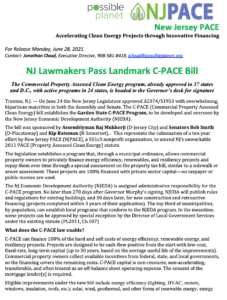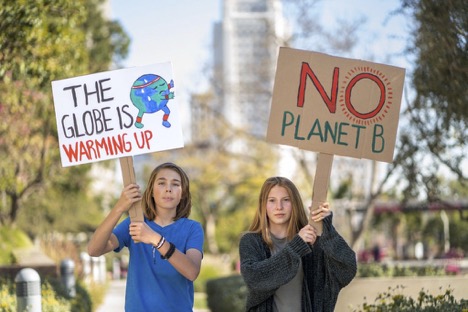 The Commercial Property Assessed Clean Energy program, already approved in 37 states and D.C., with active programs in 24 states, is headed to the Governor’s desk for signature
The Commercial Property Assessed Clean Energy program, already approved in 37 states and D.C., with active programs in 24 states, is headed to the Governor’s desk for signature
Trenton, N.J. — On June 24 the New Jersey Legislature approved A2374/S1953 with overwhelming, bipartisan majorities in both the Assembly and Senate. The C-PACE (Commercial Property Assessed Clean Energy) bill establishes the Garden State C-PACE Program, to be developed and overseen by the New Jersey Economic Development Authority (NJEDA).
The bill was sponsored by Assemblyman Raj Mukherji (D-Jersey City) and Senators Bob Smith (D-Piscataway) and Kip Bateman (R-Somerset). This represents the culmination of a ten-year effort by New Jersey PACE (NJPACE), a 501c3 nonprofit organization, to amend NJ’s unworkable 2011 PACE (Property Assessed Clean Energy) statute.
The legislation establishes a program that, through a municipal ordinance, allows commercial property owners to privately finance energy efficiency, renewables, and resiliency projects and repay them over time through a special assessment on the property tax bill, similar to a sidewalk or sewer assessment. These projects are 100% financed with private sector capital—no taxpayer or public monies are used.
The NJ Economic Development Authority (NJEDA) is assigned administrative responsibility for the C-PACE program. No later than 270 days after Governor Murphy’s signing, NJEDA will publish rules and regulations for existing buildings, and 30 days later, for new construction and retroactive financing (projects completed within 3 years of their application). The top third of municipalities, by population, can establish local programs that conform to the NJEDA program. In the meantime, some projects can be approved by special exception by the Director of Local Government Services under the existing statute (PL2011, Ch.187)
What does the C-PACE law enable?
C-PACE can finance 100% of the hard and soft costs of energy efficiency, renewable energy, and resiliency projects. Projects are designed to be cash-flow positive from the start with low-cost, fixed-rate, long-term capital (up to 30 years, based on the average useful life of the improvements). Commercial property owners collect available incentives from federal, state, and local governments, so the financing covers the remaining costs. C-PACE capital is non-recourse, non-accelerating, transferable, and often treated as an off-balance sheet operating expense. The consent of the mortgage lender(s) is required.
Eligible improvements under the new bill include energy efficiency (lighting, HVAC, motors, windows, insulation, roofs, etc.); solar, wind, geothermal, and other forms of renewable energy; energy storage, microgrids, water conservation, stormwater, flood- and hurricane-resistant construction improvements; and electric vehicle charging infrastructure.
As defined in the bill, “property” means: “industrial, agricultural, or commercial property; residential property containing five or more dwelling units; common areas of condominiums and other planned real estate developments; and property owned by a tax-exempt or nonprofit entity, including, but not limited to, schools, hospitals, institutions of higher education, or religious institutions.” Other requirements include that improvements be permanently affixed to a property and be located in a municipality that has opted into the program.
What this could mean for New Jersey, if effectively implemented:
- Cost savings on energy with no out-of-pocket expenses, attracting/retaining businesses
- Well-paying green jobs (generating 12-15 person-years per million dollars invested)
- Lower cost of capital for new development, gut/rehab, and adaptive reuse
- Upgraded building stock, making communities more resilient and competitive
- Reduced carbon footprint, contributing to climate goals and improving quality of life, especially in environmental justice communities
Buildings account for forty percent or more of greenhouse gas emissions overall, and 60-70% in older urban areas. C-PACE can go a long way towards halving, and then eliminating greenhouse gas emissions, helping New Jersey meet its Climate targets for 2030 and 2050. And since the program provides equal access to capital, C-PACE financing can positively impact low-income neighborhoods and communities of color that are often the most polluted.
Jonathan Cloud, Executive Director of New Jersey PACE, says, “We believe that local, trusted advisors are key to unleashing the power of C-PACE. Our goal is to help scale C-PACE by mobilizing civic and industry leaders and their existing networks. Together, we can begin to turn the ship around and head in the direction of a clean, resilient, just, and regenerative society.”
Contact: Jonathan Cloud, Executive Director, 908-581-8418, jcloud@possibleplanet.org
New Jersey PACE (NJPACE), a longstanding champion for C-PACE in NJ, thanks the following for their sustained and concerted efforts to make C-PACE available in NJ:
- Senators Bob Smith and Kip Bateman
- Assembly members Raj Mukherji, James Kennedy, and former members Nancy Pinkin and Upendra Chivukula (now a BPU Commissioner)
- Members of the Governor’s staff, the Department of Community Affairs, and NJEDA for their input
- Cliff Kellogg, Executive Director, and members of the C-PACE Alliance, a network of capital providers committed to achieving C-PACE’s potential
- Doug O’Malley, Director of Environment NJ
- Colin Bishopp, Executive Director of PACENation, the national industry association
- Genevieve Sherman, John C. Kinney, Abby Johnson, Bali Kumar and others, for ongoing C-PACE guidance
- Emma Horst-Martz and NJ Public Interest Research Group (NJPIRG)
- Attorney Bill Potter and retired Legislative Consultant Don Sico
- Former Governor James Florio and other members of the NJPACE Advisory Council
For more information, please see:
NewJerseyPACE.org | RegenerativeFinancing.org | PossiblePlanet.org
Click here to download a PDF of the press release.














